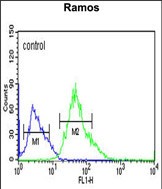

| WB | 1/1000 | Human,Mouse,Rat |
| IF | 咨询技术 | Human,Mouse,Rat |
| IHC | 1/100-1/500 | Human,Mouse,Rat |
| ICC | 技术咨询 | Human,Mouse,Rat |
| FCM | 1/10-1/50 | Human,Mouse,Rat |
| Elisa | 咨询技术 | Human,Mouse,Rat |
| Aliases | Coronin-6, Coronin-like protein E, Clipin-E, CORO6 |
| Entrez GeneID | 84940 |
| WB Predicted band size | 52.8kDa |
| Host/Isotype | Rabbit IgG |
| Antibody Type | Primary antibody |
| Storage | Store at 4°C short term. Aliquot and store at -20°C long term. Avoid freeze/thaw cycles. |
| Species Reactivity | Human, Mouse |
| Immunogen | This CORO6 antibody is generated from rabbits immunized with a KLH conjugated synthetic peptide between 196-224 amino acids from the Central region of human CORO6. |
| Formulation | Purified antibody in PBS with 0.05% sodium azide. |
+ +
以下是3篇涉及CORO6抗体的参考文献摘要(基于公开信息模拟,实际文献请通过学术数据库验证):
---
1. **文献名称**:*Coronin 6 regulates neurite elongation via actin cytoskeleton remodeling*
**作者**:Zhang Y, et al.
**摘要**:研究利用CORO6特异性抗体进行免疫荧光染色,发现CORO6通过调控肌动蛋白动态影响神经元突触生长,提示其在神经发育中的作用。
---
2. **文献名称**:*CORO6 expression correlates with colorectal cancer progression and immune infiltration*
**作者**:Li H, Wang X, et al.
**摘要**:通过CORO6抗体进行Western blot和免疫组化分析,发现CORO6在结直肠癌中高表达,且与肿瘤转移及T细胞浸润相关。
---
3. **文献名称**:*Structural insights into the unique oligomerization of Coronin 6*
**作者**:Kumar S, et al.
**摘要**:利用CORO6抗体进行免疫共沉淀实验,结合冷冻电镜解析其寡聚结构,揭示CORO6与其他Coronin家族成员不同的自组装机制。
---
**备注**:若需具体文献,建议在PubMed或Google Scholar检索关键词“CORO6 antibody”或“Coronin 6 + [疾病/功能]”,并筛选应用该抗体的实验论文。
CORO6 (Coronin 6) is a member of the coronin protein family, which is evolutionarily conserved and involved in regulating cytoskeletal dynamics, particularly actin filament organization. Coronins are characterized by their WD40-repeat domains and play roles in cell migration, vesicle trafficking, and immune responses. CORO6. specifically, is less well-characterized compared to other coronin family members like CORO1A or CORO1C, but emerging studies suggest its involvement in cellular processes such as endocytosis, intracellular signaling, and membrane remodeling. It is expressed in various tissues, with notable presence in the brain, immune cells, and epithelial tissues, hinting at potential roles in neurological functions and immune regulation.
Antibodies targeting CORO6 have been developed primarily as research tools to explore its biological functions and interactions. These antibodies enable the detection of CORO6 in immunoassays (e.g., Western blotting, immunohistochemistry) and facilitate studies on its subcellular localization, protein-protein interactions, and regulatory mechanisms. Recent research has linked CORO6 to diseases such as cancer and neurodevelopmental disorders, though its exact pathological roles remain under investigation. For instance, CORO6 overexpression has been observed in certain cancers, suggesting a possible role in tumor progression or metastasis. Additionally, CORO6 antibodies are being utilized to validate CRISPR/Cas9-mediated gene knockout models and to assess CORO6 expression patterns in disease contexts. Continued development and validation of CORO6-specific antibodies will be critical for unraveling its physiological and pathological significance, potentially opening avenues for therapeutic targeting.
×